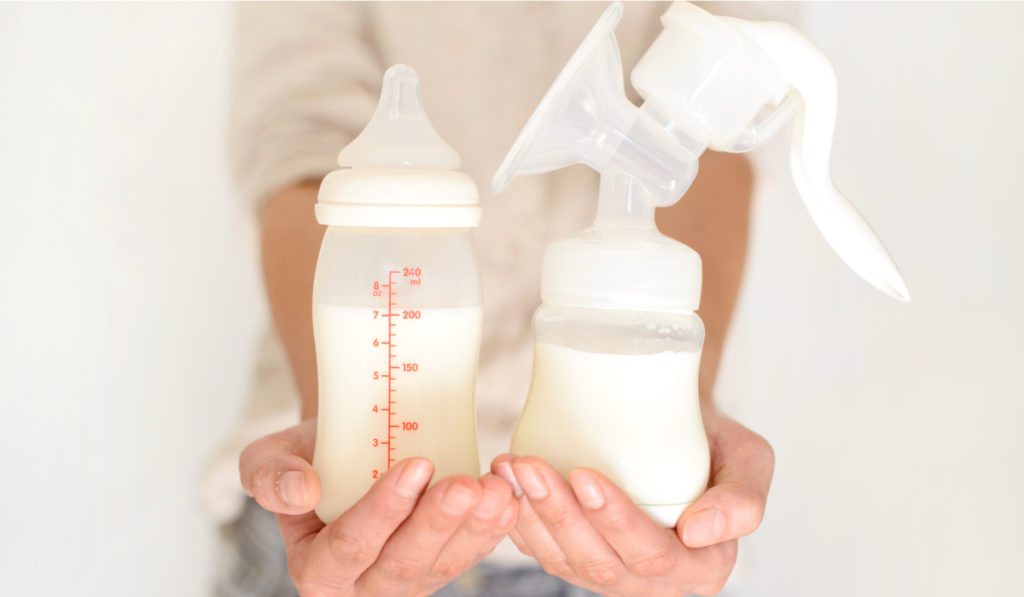From experienced mothers that already have kids to newly soon-to-be expecting moms, there will always be a need to see how any substances that the mother consumes will affect a developing fetus or a nursing baby drinking a mother’s milk.
Just like tobacco smoke, cannabis smoke, street substances, or alcoholic beverages, caution must be exerted when their consumption interferes with fetal development or early childhood outcomes in growth, even if used in small quantities.
Due to the recent legality of CBD products by the 2018 Agriculture Improvement Act, there is not enough research from any recent study published that establishes any significant link that correlates breastfeeding mothers and cannabinoid concentrations being harmful to newborn children who drink breast milk.
However, using the little published research currently available to us and the previous studies covering maternal marijuana use during pregnancy conducted by American college laboratories, we can begin to form a science-backed picture of the long-term effects that cannabis product consumption can have on neonatal and childhood outcomes.
The science behind CBD
Cannabidiol (or CBD) is the main psychoactive component that makes up the cannabis plant. While not as potent as the primary cannabis component, tetrahydrocannabinol THC used in medical marijuana use, CBD does not have the intense, intoxicating effects caused by its THC counterpart.
Despite this fact, CBD is still an active chemical compound with several beneficial effects attached to its frequent use. Therefore, it may still have long-term effects on a breastfed baby, and this observation comes from examining CBD in its isolated form.
More caution should be added in real-world use of full spectrum CBD cannabis-derived products, because not only do they contain CBD and trace amounts of THC, but also hundreds of potential other cannabis compounds found within the hemp plant.
Cannabis plant CBD properties
Even less research has been conducted on the specific effects of these other cannabinoid compounds, so it becomes even more difficult to determine any potentially harmful components to a breastfed baby.
The use of full-spectrum CBD while breastfeeding should not be taken lightly as this large combination of cannabinoids leaves many questions as to their interactions with so little scientific data.
One of the main concerns when it comes to nursing mothers and any form of marijuana use during pregnancy is the cannabis property of its chemicals being metabolized by the body through fat molecules rather than water molecules like most other substances.
Fat soluble vs water-soluble
Most prescription medications that are taken can be classified as water-soluble chemicals, meaning they are processed by the body through water molecules. This means residual traces of those substances only stay in your system for a maximum of 3-5 days and are expelled from the body by way of bodily fluids, such as either sweating or urinating.
In contrast, fat-soluble compounds such as CBD oil or other cannabis products are processed by your body through fatty tissues. This causes trace amounts to remain inside the body for extended periods of time, since the compounds cannot be expunged through the excretion of bodily fluids. Instead, these molecules collect within fat cells and can only be ridden over time as the fat cells are metabolized alongside food molecules in the liver.
Picture a half-filled glass of just plain old water, which represents your body’s system of fluids. Now imagine two droppers: one filled with blue food coloring, representing water-based solubles, and the other filled with cooking oil, representing fat-based solubles.
If a couple of drops of the blue food coloring are added to the cup of water, it will mix evenly, spreading throughout the water until it is all a blue tint water mixture. It is indistinguishable in texture or composition from the original clear water, just taking on the blue imagery.
If the new bluish-tinted water is then poured out of the cup, it will move down the stream together, emptying out in equal proportion to the original water.
Now imagine pouring out the blue water and pouring in just water again into the cup to restart the metaphor.
Conversely, if we add a few droplets of cooking oil to the plain H2O water, the oil compounds will clump together on top of the water, creating an uneven mixture without ever-amassing, like the food coloring.
When the oily-water concoction is poured out, it will slide out of the cup with the water primarily leaving first with some oil but inside the cup, the remaining mixture is still layered with the oil on top and the water on the bottom.
Unlike THC, water molecules do not stack up inside the body longer than the time period of which they are consumed, despite what amounts are taken. Fatty soluble substances are stacked inside the aforementioned fat cells with frequency of use.
The more you consume, the longer it will take for the amounts inside fatty tissues to metabolize and leave the body.
The link between fat-tissue soluble compounds and breast milk
Since most of the nutrients found within breast milk are in the form of fat molecules, the possibility of breastfed babies being exposed to CBD and other marijuana compounds is very high after the mother’s intake.
This chance is only further increased by the frequency of use and because a mother’s milk production is compromised until sufficient time has passed, instead of being able to pump and dump the breast milk toxins out of their systems like with alcohol, there is no alternative method currently available that will purify a nursing mothers milk sample of said cannabinoids.
How long can CBD from hemp plants stay in your body?
Breast milk samples show trace amounts of CBD molecules from any cannabis use are detectable up to six days after its use.
Nevertheless, this figure should only be seen as a rough average of time, since detectable CBD amounts from breastfeeding mothers heavily depend on the frequency of use, dosage amounts, level of concentration, and many other minor factors.
Cannabis traces found in the bloodstream of consistent, heavy cannabis users can last several weeks from the last time consumed.
Why would nursing mothers want to use CBD?
There is a long list of why moms would need a maternal dose of CBD products since there are multiple benefits that it carries, such as:
- Chronic discomfort relief
- Stress management
- Physical challenges arising from muscle soreness
- Difficulty falling asleep from general restlessness
- Rejuvenation of a person’s hair, skin, and nails
These effects can be seen in a wide variety of CBD products that can be consumed by an individual based on their personal preference.
While the form of CBD products that are consumed does not matter when researching marijuana use during pregnancy and its presence in breastmilk afterward, mothers who require the positive results from cannabis products and opt to choose one of the alternatives listed at the end of the article can rest easy knowing these are amongst the highest quality in the online marketplace.
A few examples out of the many CBD products available on the market to moms:
- A few drops of CBD oil tincture 1000 mg under the tongue to fall asleep faster and stay asleep longer, improving overall REM quality of your resting period.
- Massaging strained muscle fibers with CBD rubbing balm after a day of heavy mom style lifting.
- Winding down from a stressful day with CBD gummies as a post-dinner snack after placing the kids to bed.
Why should breastfeeding mothers worry about having CBD in their milk samples?
Unfortunately because of all the reasons mentioned above, CBD should be avoided if breastfeeding to ensure those same harmful components that have been observed in large concentrations of tetrahydrocannabinol THC exposure in newborn babies is possible within the mixed cannabinoid recipe found in full spectrum CBD.
Can CBD be dangerous to newborn babies?
Apart from the correlation between pure CBD and its presence within human milk coming from breastfeeding parents, there is the added danger of the newborn baby ingesting harmful chemicals through the breast milk from consumption of unregulated, low-quality CBD products. Cannabis use from these items can bring impurities like heavy metals and other contaminants that are much more harmful than anything marijuana-related.
Are there any risks for infants exposed to hemp plant CBD compounds in human breast milk?
Until more scientific studies are conducted, it is safest to go off the few pieces of concrete evidence we have when it comes to cannabis-infused breast milk effects on newborns.
Knowing that the human endocannabinoid system and its receptors are naturally occurring and have important functions relating to motor function, hand-eye coordination, and immune system configuration, to name a few, it is safe to assume prolonged overloading of a newborn’s system during the postpartum period may have any (or all) of the following consequences:
- Impaired brain development resulting in poor cognitive function
- Trouble with motor functions from complications in nervous system development
- Compromised immune system disease control resulting in higher frequencies of illness from a lower immunological function such as ear infections
Cannabinoid concentrations in breast milk and sudden infant death syndrome
Because these are not the only complications that may arise from having cannabinoids within breast milk while nursing, one must consider the worst possible scenario of Sudden Infant Death Syndrome (or SIDS).
This unfortunate medical phenomenon has been observed for decades, yet an exact cause has not been found. Instead, medical professionals have detected strong correlations between SIDS and a newborn’s exposure to harmful toxins, among many other factors.
However, due to so many possible variables having roles in causing this issue (including genetic predispositions), avoiding all harmful substances at all costs becomes impossible considering there are slight amounts of some harmful compounds in the very air everyone breathes. The best thing to do is to be as careful as possible and reduce the probability to the lowest within your control.
Please refer to your primary healthcare provider if you have any questions, comments, or concerns with the help of your newborn baby’s health.
Is there a safe way to consume CBD while breastfeeding?
As of the time of writing this article in 2022, there is no science-backed method of cannabis CBD consumption that guarantees a safe way that keeps the cannabis compounds found in full-spectrum CBD products from entering breastmilk and exposing themselves to your nursing young child.
As a mother, we know that your child’s safety and well-being are at the top of your priority list above anything else. That being said, there are some individuals who need to supplement CBD in order to help with certain life factors that weigh them and affect their day-to-day activities. There aren’t many options, but two things you can do are:
- Schedule your CBD usage around the pumping of breastmilk and freeze as many quantities as possible to use when CBD molecules are found in your system, always test the breast milk after detoxing to ensure there are no detectable amounts.
- Utilize baby formula powder as a substitute for breast milk if available in your local area.
We hope our Supermom article has been informative and has helped as a guide in your CBD journey!



